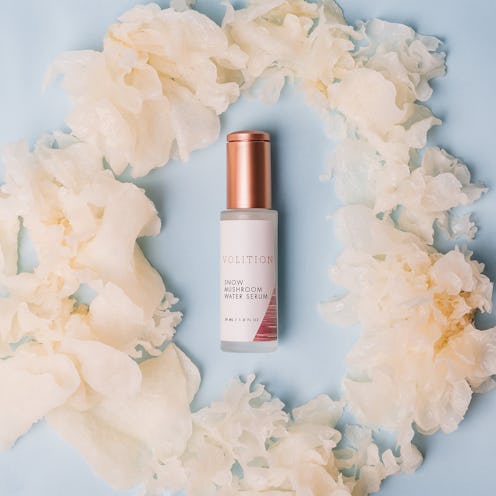(Beauty)
Is This The New Hyaluronic Acid?

Mushrooms are having what’s known as A Moment. The antioxidant-filled fungi are suddenly everywhere: Chaga and cordyceps mushrooms have made their way into adaptogenic smoothie supplements, powdered lion’s mane mushrooms are today’s healthiest alternative to coffee, and reishi mushrooms are the star ingredient in skincare products like Youth to the People’s Adaptogenic Moisture Cream. But the latest ‘shroom on the block, snow mushroom, is arguably the best yet. With its capacity for locking in moisture, snow mushroom in skincare products is about to replace hyaluronic acid as the gold-standard.
But don’t let the hype fool you; this is hardly a “new” skincare ingredient. “Snow mushrooms, technically known as Tremella fuciformis, are quite the buzz lately,” Dr. Aanand Geria, a dermatologist at Geria Dermatology in New Jersey, tells The Zoe Report. “But ironically, they date back thousands of years and are used frequently in Asian skincare products.” Recently, the ingredient has made its way into the U.S. mainstream — in products like AVYA Skincare Day Moisturizer and Olay Active Botanicals Intensive Night Cream — for its “tremendous hydrating capabilities,” Geria says. And as most beauty enthusiasts know, hydration is key for fighting everything from acne to aging, not to mention for a next-level glow.
In fact, the power of the snow mushroom rivals that of skincare’s reigning champ of moisturization, hyaluronic acid. “In a laboratory, hyaluronic acid can hold 1000 times its weight in water, and snow mushroom can hold 500 times its weight,” Dr. Tanuj Nakra, co-founder of AVYA Skincare, tells The Zoe Report. “However, snow mushroom’s gelatinous molecules are smaller than that of hyaluronic acid, so they penetrate the skin much better — leading to more noticeable, real-world results.” In other words, snow mushroom holds less water than hyaluronic acid, but it actually delivers more moisture to the skin due to the smaller particle size. Bonus: Since mushrooms are relatively inexpensive to grow and harvest, the pricing of snow mushroom-infused products is on par with that of hyaluronic acid, too.
Speaking from personal experience, snow mushroom also has the dreamiest texture — Dr. Geria calls it “jelly-like,” and I agree. That doesn’t mean it’s sticky, though. It’s more thick and bouncy, which really shines in Moon Juice Beauty Shroom Plumping Jelly Serum… and yet, despite its luxuriously thick feel, it sinks into the skin quickly. (Talk about magic mushrooms.)
Another plus for clean skincare lovers: snow mushroom is totally natural. To be fair, hyaluronic acid does naturally occur in our skin, as well — but “the hyaluronic acid used in skincare is manufactured by commercial bacterial synthesis,” Dr. Nakra explains. “In contrast, snow mushroom is incorporated into skincare products as a dried but otherwise unaltered natural form.” If you’re dedicated to that #cleanbeauty life, then snow mushroom may be a better fit for you.
“A major benefit of using the natural mushroom [instead of hyaluronic acid] is the slew of other active molecules that have a powerful effect on our skin’s health and beauty,” Dr. Nakra adds; including antioxidants to fight environmental damage and keep skin looking young. And as far as risks? “There really aren’t any — it’s safe to use on all skin types,” Dr. Adarsh Vijay Mudgil, medical director of Mudgil Dermatology, tells The Zoe Report. Since snow mushroom hydrates sans oils, it's even recommended for those with oily skin.
The one downside? Since snow mushroom is beloved by natural beauty brands, products formulated with this ingredient may have a shorter shelf life than those that feature hyaluronic acid, depending on the preservatives used (but this will differ from product to product).
Ahead, discover the (ancient) new ingredient your skincare routine is thirsty for.
Shop Snow Mushroom Skincare
This article was originally published on